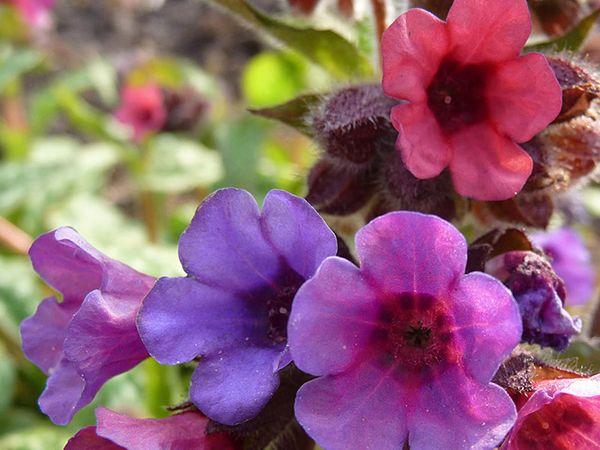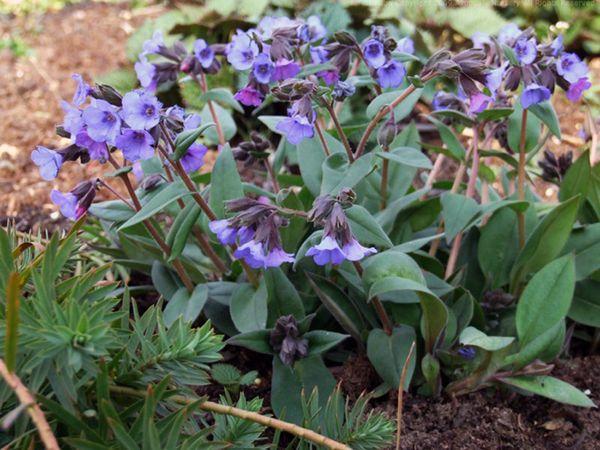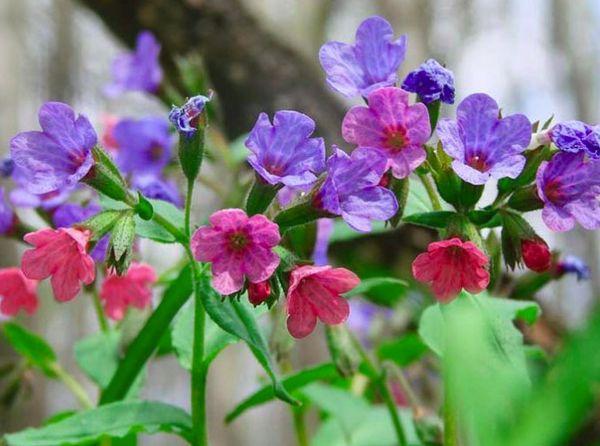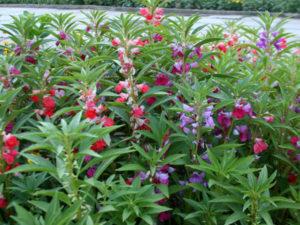Rules for planting and caring for lungwort in the open field, varieties and cultivation
The lungwort does not differ in large and bright flowers, on the contrary, they are small. A special feature is that all flowers are multicolored: blue, lilac, crimson and pale pink. The eyes are attracted by spotted leaves collected in a chic bush. The lungwort is unpretentious in planting and care, grows well in the open field.
General description of the plant
Pulmonaria is the second name of the plant. Belongs to the Burachnikov family. The plant has a straight, downy stem, up to 30 centimeters in height. Basal leaf, long petiolate, velvety. It has an elliptical shape, with a pointed end.
Flowering begins as soon as the snow melts and continues until May. Inflorescence with small flowers, collected in a scutellum and located at the top of the stem. Flowering is non-simultaneous. A young flower throws out a pink bud, then begins to darken, up to lilac. Because of this feature, it turns out that flowers of different colors are in the inflorescence.
Bees love the honeybee, as this plant is a honey plant. Its young leaves are rich in potassium salts, calcium, iron, nickel, they are added to salad. Contains vitamin C, carotene and rutin. These elements will be preserved even when boiled, marinated and dried.
Interesting! In England, lungwort is grown in large quantities. It is because of its beneficial properties.
The appearance of the plant may differ slightly between different types of pulmonaria.
Types and varieties of lungwort
Breeders have turned a nondescript forest flower into an ornamental pet that many gardeners grow. There are 15 natural species and about 20 bred varieties.

The most decorative types include:
- Lumpy lungwort is rare. Spectacular and heat-loving look. It differs from all species in unusually large leaves. In early spring, their color is green, with silvery spots, and by summer the spots, merging, fill the entire leaf, and it becomes silvery. The Majesti variety is very similar in leaf color. The inflorescences bloom in early spring and are purple-red in color.
- Red lungwort. The earliest of the species. The flowers are bright red. Differs in long flowering. Bushes of small, solid green leaves grow rapidly and form a dense canopy.
- Medicinal lungwort grows to a height of no more than 30 centimeters. Differs in high winter hardiness. Withstands frosts down to -35 ° C without damage to the root system. Flowering begins in mid-May and lasts a month.The inflorescence changes color: from red shades at the beginning of flowering to purple at the very end.
- The softest pulmonaria during growth forms dense and large bushes, no more than 50 centimeters high. Peduncles with large blue-violet flowers are formed at the end of April. Juicy green leaves are formed throughout the summer.
- Long-leaved lungwort grows only up to 25 centimeters in height. Has a very spectacular leaf coloring. On the dark green base of the leaf, there are silvery blotches of different sizes. The lower part is gray-green. The long-leaved species can be planted in a sunny location. Rose buds open in April. Over time, they change color to blue.
- The lungwort is unclear. Leaves are green. When blooming, the color of the flowers changes - from pale pink to dark lilac. This species prefers light and fertilized soils.
- Sugar lungwort has a second name - spotted borage, sugar. It is considered a ground cover and evergreen. Its leaves create a huge green carpet, and with the arrival of spring it turns purple.
Besides the plant species, there are popular garden varieties of this flower.

Samurai hybrid variety. It reaches a height of 30 centimeters. It has a spreading crown with green foliage and an erect stem. Burgundy and purple flowers open in May and continue to bloom until June. They are planted in partial shade and in light areas.
The Majestic variety is considered the most popular. It cannot be confused with other varieties. Its leaves are light green in spring and brighter in summer, with a silvery tint. The pink flowers turn blue later. It tolerates weather changes and wintering well.
Landing features
In order for the plant to take root well and delight every year with the first flowers, you need to take into account some features of planting.

Pick up time and place
Spring is the best time for planting lungwort in a permanent place in open ground. The first days of April are the period when the earth is most rich in nutrients. And this is important for good rooting and flower development.
It grows well, both in the shade and in partial shade. Can also be planted in a sunny location, but not in direct sunlight.
Preparing the soil for planting
Loves fertile soils and does not tolerate stagnant water. Choose a well-drained site. Before planting lungwort in the ground, you need to prepare a place in advance. In a week, the earth needs to be dug up, all weeds removed and fertilized with humus.

Step-by-step planting instructions
The technology of planting young seedlings is not complicated. Even a novice florist will master:
- In a previously prepared area, you need to make holes for planting. They must be at a certain distance - 20-25 centimeters - from each other.
- If the area is prone to moisture stagnation, then drainage should be placed on the bottom of the hole: coarse sand, expanded clay or small pebbles.
- Seedlings are removed from the planting cups along with the ground, being careful not to damage the plant. To do this, you first need to water, wait a little. Turn the plant over on your palm, holding the stem between your fingers.
- Place the flower in a hole, crush it with earth to the base and compact with your hands.
- Water the plant with clean water and sprinkle with sawdust.
In the right place, the plant will quickly take over and grow.
Important! When planting, the lungwort does not need to be deeply buried in the ground.
Correct care
There are some important points in the care and cultivation of decorative lungwort that will not take much time.
Watering and mulching
Watering is important for lungwort. She accepts abundant and regular hydration. But she also does not like excess moisture. Depending on the soil on which the plant grows, you need to choose the necessary mode for watering.
Moistening is considered the best option when the topsoil under the bush begins to dry out. The lungwort prefers loose and light soils. Therefore, loosening of the top layer is carried out regularly. This procedure provides oxygen access to the roots and improves fluid permeability to them. In order for the moisture to remain under the bush as long as possible, the ground around it must be mulched with peat or sawdust.

Fertilizer
Needs feeding during active leaf growth and bud formation. Fertilized, mainly: mineral complex compounds and organic matter. They are distributed under the lungwort bush. Fertilizers can also be diluted in water. Take 20 grams of the mineral composition and dissolve in 10 liters of clean and warm water.
Do I need to cut the lungwort?
In the spring, old and dried leaves are cut off so that the young shoots do not rot, and a well-groomed appearance is preserved. After flowering, the peduncles are cut so that seeds are not scattered.
You cannot cut off the leaves of the plant in the fall, as they serve as a heater for the roots. All cuts on the plant should be done with a clean and well-sharpened tool.
Preparing for winter
As for the lungwort plant, preparing for winter does not require much trouble. The plant calmly tolerates this period, except for two types of plants: valate and soft. In autumn they are covered with leaves, peat or grass. The rest of the species are mulched with sawdust or peat.

Diseases and pests
A big plus of lungwort is its immunity to diseases. Pests also bypass this plant. An exception may be slugs and snails, which are attracted by the dampness under the bush due to excessive watering.
To prevent the appearance of these pests, you need to remove the weeds in time and not flood the plant.
Breeding methods
There are several ways to propagate lungwort.
By dividing the plant. Using this method, the varietal characteristics of a perennial flower are preserved. In the spring, you need to dig out the bush, cut the root into pieces. The resulting material is planted in holes at a distance of 30 centimeters from each other. You need to adhere to the same depth at which the flower grew before the separation of the bush.

If in the spring it was not possible to divide the bush, in the fall it is also possible. After the faded flowers begin to fall off the plant, it's time. In this way, sugar and long-leaved pulmonaria are propagated.
Sections of roots. At the end of summer, they dig up a bush and cut off the parts of the root from it, which have a bud. Then they are planted in prepared pits to a depth of 4 centimeters. In this way, the gross, medicinal and narrow-leaved species of lungwort are propagated. The distance between the pits should be more than 30 centimeters, as these species grow strongly.
Seeds. This method is rarely used. Only the softest lungwort grows well from seeds. The rest of the species, with this method, lose the qualities of the mother plant. Flowering begins only at 2 years.
Seeds quickly lose their germination, so they need to be planted in the harvest year.

Decorative properties
This primrose, due to the color of the leaves and early flowers, looks great in group plantings of early flowers in flower beds. Naturally, this shrub looks among the conifers, forming a dense carpet around them.
The lungwort is planted along the edge of the curbs, it frames them aesthetically. It is irreplaceable in alpine slides, and in group plantings of summer flowers: phlox, astilbe, daylilies. Looks very good in a composition with hosta of various varieties.
The lungwort is a flower that tolerates shade well. It will be a decoration of a shady corner where other flowers do not grow. And in the spring it will delight you with the first flowers. Her gorgeous bush of bright leaves will be appropriate in any part of the garden.









